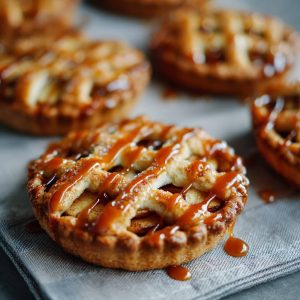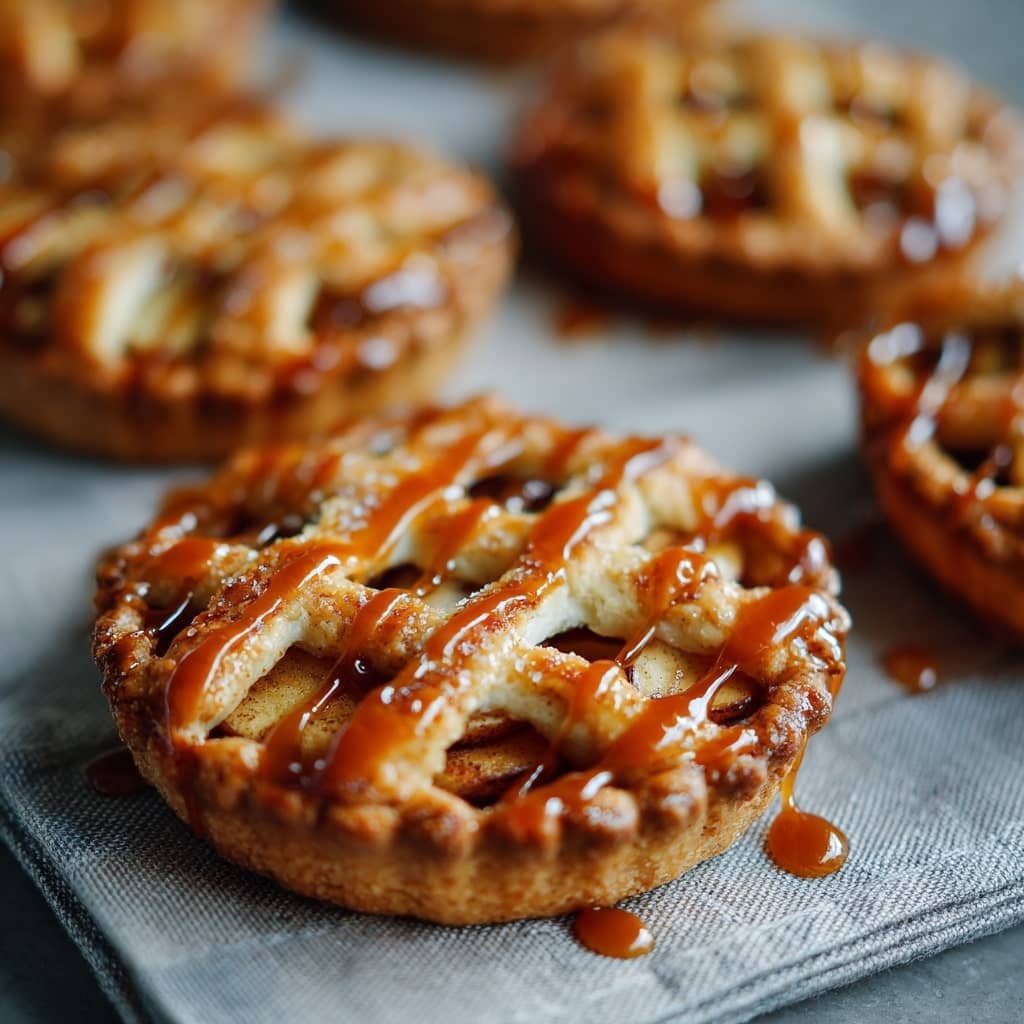Introduction
There are few desserts that deliver the perfect balance of texture and flavor quite like thick and chewy salted caramel cookie bars. These indulgent bars are a symphony of contrasting sensations—soft and gooey centers, golden crisp edges, and layers of buttery richness paired with the deep, sophisticated notes of salted caramel. Ideal for everything from casual get-togethers to holiday dessert trays, these cookie bars are a guaranteed crowd-pleaser. What sets them apart is not just their generous thickness or the luscious caramel woven through the dough, but the balance of salty and sweet that elevates them from ordinary to extraordinary. Each bite brings a chewy, melt-in-your-mouth experience that feels both nostalgic and gourmet. Whether you’re baking for a special occasion or just want to treat yourself, these bars will become a staple in your recipe box—a comfort food that’s as impressive as it is simple.
The History of Salted Caramel Cookie Bars
The story of salted caramel cookie bars is an evolution of two beloved treats: the traditional cookie bar and the now-iconic salted caramel. Cookie bars, as a format, emerged in the mid-20th century during the rise of convenience baking, when home bakers began adapting drop cookie recipes into bar form for quicker preparation and easier serving. Around the same time, caramel had already become a mainstay in American confections, but it wasn’t until the late 1990s and early 2000s that the culinary world experienced a salted caramel renaissance. This flavor profile—popularized by French pastry chefs and quickly adopted by American bakers—took the sweet treat world by storm. By introducing a touch of sea salt to the deep, rich flavor of caramel, chefs discovered a way to amplify sweetness and add complexity. Merging the simplicity of cookie bars with the sophistication of salted caramel resulted in a dessert that feels both homey and elevated. Today, salted caramel cookie bars are found everywhere from bakeries to food blogs, beloved for their luxurious texture and crave-worthy flavor.
Ingredients Breakdown
For the cookie bar dough: 2 1/2 cups (325g) all-purpose flour – forms the structural base of the bars and gives them heft; 1 teaspoon baking soda – helps the bars rise slightly and stay tender; 1/2 teaspoon salt – enhances flavor; 1 cup (227g) unsalted butter, softened – adds moisture and rich flavor; 1 cup (200g) packed light brown sugar – contributes chewiness and deep caramel flavor; 1/2 cup (100g) granulated sugar – gives the edges a subtle crispness; 2 large eggs – bind the dough and provide structure; 2 teaspoons vanilla extract – rounds out and deepens the flavor. For the caramel layer: 1 cup (300g) thick caramel sauce – acts as the gooey, sweet centerpiece; 1/2 teaspoon flaky sea salt – adds contrast and complexity to the sweetness. Optional: 1 cup (170g) chocolate chips or chopped chocolate – for added richness and depth; 1/2 cup (60g) chopped pecans or walnuts – for crunch and nuttiness (optional, based on preference).
Step-by-Step Recipe
- Preheat your oven and prepare your pan: Set your oven to 350°F (175°C). Line a 9×13-inch baking dish with parchment paper, leaving an overhang on the sides for easy removal, and lightly grease it. 2. Mix the dry ingredients: In a medium bowl, whisk together the flour, baking soda, and salt. Set this aside. 3. Cream the butter and sugars: In a large mixing bowl, beat the softened butter, brown sugar, and granulated sugar together on medium speed for about 2–3 minutes, until light and fluffy. 4. Add eggs and vanilla: Add in the eggs one at a time, beating well after each addition. Stir in the vanilla extract. 5. Incorporate the dry ingredients: Gradually add the flour mixture to the wet ingredients, mixing just until combined. Avoid overmixing to keep the texture soft and tender. 6. Assemble the layers: Press two-thirds of the cookie dough into the bottom of your prepared baking dish in an even layer. Smooth it out with a spatula or the back of a spoon. 7. Add caramel and salt: Pour the thick caramel sauce evenly over the base layer, spreading it out to all edges. Sprinkle flaky sea salt over the caramel for that signature salty-sweet flavor. 8. Top with remaining dough: Drop spoonfuls of the remaining cookie dough over the caramel layer. It’s okay if some caramel peeks through—it creates beautiful texture and visual appeal. 9. Bake: Place the pan in the oven and bake for 28–35 minutes, or until the top is golden brown and set. The center may jiggle slightly but will firm up as it cools. 10. Cool completely: Allow the bars to cool in the pan for at least 1 hour before lifting them out using the parchment paper overhang. For cleaner cuts, refrigerate the cooled bars for 30 minutes before slicing. 11. Serve and enjoy: Slice into squares or rectangles and serve slightly warm or at room temperature for the ultimate gooey experience.
Tips for the Perfect Cookie Bars
Use room temperature butter and eggs to ensure a smooth, even mixture. Always measure flour properly by spooning it into your measuring cup and leveling off to avoid dense bars. Don’t overmix the dough—once the flour is incorporated, stop mixing. If your caramel sauce is too thin, simmer it gently to reduce and thicken before layering. For extra gooeyness, underbake slightly by 1–2 minutes, then allow bars to finish setting as they cool. Chill before slicing for perfectly clean edges. Don’t skip the sea salt—it makes the caramel shine and prevents the bars from being overly sweet. Store leftovers in an airtight container to keep them soft and chewy for days.
Variations and Customizations
Chocolate lovers can mix in chocolate chunks or drizzle melted chocolate over the finished bars. Nutty twist: Add chopped pecans, almonds, or macadamia nuts into the dough or sprinkle over the caramel for added texture. Coconut caramel bars: Add shredded coconut to the caramel layer for a tropical flair. Spiced version: Add a pinch of cinnamon or nutmeg to the dough for warmth and depth, especially in cooler months. Stuffed bars: Place a layer of mini marshmallows or even crushed pretzels between the dough and caramel for extra layers of flavor. Gluten-free option: Substitute the all-purpose flour with a 1:1 gluten-free flour blend. Vegan version: Use vegan butter, a flax egg (1 tbsp flaxseed meal + 3 tbsp water), and dairy-free caramel sauce.
Health Considerations and Nutritional Value
Salted caramel cookie bars are undoubtedly a rich and indulgent treat, intended for special occasions rather than daily snacking. Each bar can range from 250 to 400 calories depending on size and ingredients used, with most of those calories coming from fats and sugars. The butter and eggs provide some protein and fat-soluble vitamins like A and D, while the sugar content is quite high due to both the caramel and the dough. These bars are also high in saturated fat and should be enjoyed in moderation. For a lighter option, consider using less sugar, replacing some butter with unsweetened applesauce, or making smaller portion sizes. The sea salt, though a small addition, helps with flavor balance and prevents overindulgence by satisfying the palate more quickly. They are not suitable for those on low-sugar, low-fat, or low-sodium diets unless adjusted. However, they are naturally free from artificial preservatives when made from scratch and can be made gluten-free or dairy-free with suitable substitutes.
FAQ
Q: Can I use store-bought caramel sauce? A: Yes, but make sure it’s thick enough to stay in place during baking. Thin sauces may leak into the bottom layer. Q: How do I know when they’re done baking? A: The top should be golden brown and mostly set, though the center might look slightly soft—it will firm up as it cools. Q: Can I freeze these bars? A: Absolutely. Once cooled and sliced, wrap each bar tightly in plastic wrap and store in a freezer-safe bag for up to 2 months. Thaw at room temperature or reheat gently before serving. Q: How long do they last? A: Stored in an airtight container at room temperature, they’ll stay fresh for 3–4 days, or up to a week if refrigerated. Q: Can I double the recipe? A: Yes, just use a larger baking dish or bake in two batches for best results. Q: Why is my caramel layer too runny? A: The caramel sauce may have been too thin or too warm when added. Let it cool and thicken slightly before layering onto the dough.

Caramel Apple Pie Cookies
Ingredients
For the Hard Caramel:
- 1 batch of 5-Minute Hard Caramel
- For the Cookie Dough:
- 1 1/2 cups 330g packed light brown sugar
- 16 tablespoons 226g unsalted butter, at room temperature
- 1/2 cup 100g granulated sugar
- 1 1/2 tablespoons 19g pure vanilla extract
- 2 large eggs at room temperature
- 1 teaspoon baking powder
- 1 teaspoon baking soda
- 1 teaspoon sea salt
- 3 1/4 cups 439g all-purpose flour (measured correctly)
- 1 1/2 cups 255g dark chocolate, coarsely chopped or chocolate chips
- Flaky sea salt for sprinkling on top optional
Instructions
For the Caramel:
- Begin by following the directions from the “How to Make Hard Caramel” recipe, stopping when the melted sugar turns a rich golden bronze color. Once it reaches the desired hue, immediately pour the hot caramel onto a prepared baking sheet. Use a spatula to spread it out evenly to a thickness of about 1/4 to 1/8 inch. Allow the caramel to cool completely and harden. Once hardened, chop the caramel into small, chocolate chip-sized pieces and set aside until ready to use.
For the Cookies:
- Preheat your oven to 350°F (177°C) and line several baking sheets with parchment paper to prepare for baking.
- In the bowl of a stand mixer fitted with the paddle attachment, combine the brown sugar, granulated sugar, unsalted butter, and vanilla extract. Cream the mixture on medium speed for 4 to 5 minutes, until it becomes light in color and fluffy in texture.
- Add the eggs one at a time, ensuring the first egg is fully incorporated before adding the second. Mix well. Then, add the baking powder, baking soda, and sea salt, and continue to mix on medium speed for about 1 minute until everything is fully blended. Remove the bowl from the mixer.
- Add the flour to the bowl and gently mix until the dough is almost fully combined, leaving some visible streaks of flour. Scrape down the sides and bottom of the bowl to ensure no pockets of dry ingredients remain. Then, fold in the chopped dark chocolate and the prepared caramel pieces, mixing just until evenly distributed.
- Scoop the dough onto the prepared baking sheets in 2-tablespoon portions, spacing the cookie dough balls about 2 inches (5 cm) apart to allow for spreading.
- Bake the cookies one sheet at a time in the center of the oven for about 11 minutes. Remove the cookies from the oven and use the edge of a silicone spatula to gently reshape them into neat circles if needed. Return the tray to the oven and bake for one additional minute. The cookies should appear slightly underbaked in the center when you remove them—they will continue to set as they cool.
- Allow the cookies to cool on the baking sheet for 10 minutes before transferring them to a wire rack to cool completely. If desired, sprinkle the tops with flaky sea salt before serving for that extra burst of flavor. Enjoy!

